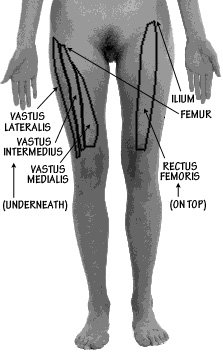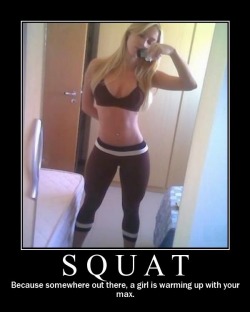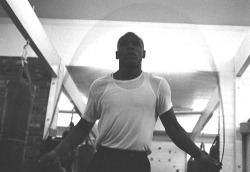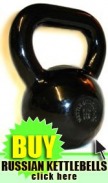Complex training involves the integration of resistance exercise followed by an explosive movement. The goal of complex training is the improvement of explosive strength and speed-strength. The resistance work activates the nervous system (Ex. barbell/kettlebell/dumbell squats), followed by an explosive movement (split jumps/tuck jumps) to target the fast twitch muscle fibers.
The roundhouse kick is generally used in varying levels (low, middle, high) to inflict damage to different parts of the opponent's body. Low kicks generally target the thigh just above the knee joint for the purpose of weakening the leg, which serves many purposes such as limiting the opponent's mobility, potentially his ability to stand on the leg altogether and his ability to use it for forceful kicks. Fighters are taught to repeatedly strike the same point on the thigh to increase the cumulative effect of low kicks as a match proceeds. Muscles of the ThighThe first target is actually four targets in one, the quadriceps femoris muscle group. The Quads. Individually, the quads consist of the rectus femoris, vastus intermedius, vastus medialis and the vastus lateralis. An effective leg kick to these muscles, trapping the muscle between the shin and your oppnents femur bone, will slowly degrade their base, deadening the legs and opening them up for body and high kicks in later rounds. Next Time... The Nerves of the ThighElite MMA athletes are some of the most well-conditioned people in the world. This is due to the high anaerobic capacity required to do five minute rounds in a sport that requires constant exertion and power. If you're fighting a wrestler, it's almost impossible not to go 90% throughout; the entire fight. Because of this, many MMA athletes have started taking on serious strength and conditioning programs that'll allow them to hang. The most important part of your strength and conditioning workout should be building core strength. This is pretty straight forward if you know what your core really represents: your hips. In order to maximize the power of your core, you'll need to do exercise the muscles that attach to and are around your hips. These are your glutes, hamstrings, quadriceps, abdominals, and spinal erectors. The two best core training exercise are the squat and deadlift, both of which will push you to your max and build up a fantastic foundation with which you can crush the competition. After you've mastered the squat and deadlift, you can move on to pure power exercises like the cleans and snatches. These are multi-step lifts that will increase your anaerobic conditioning significantly. While building core strength is definitely the most important part of mixed martial arts conditioning training, you'll also want to focus on other muscles because they all have their uses. Your biceps, for example, will be useful for powering out of arm bar attempts. Because of this, you'll want to try to hit all of the muscles in your body. Contrary to what some people will say, no muscle is useless in mixed martial arts. Your pectorals can be useful for holding onto someone on the ground or even getting your opponent off balance so you can sweep them.
When you're working out, you'll want to use reps in the 3-5 range. Anything more and you'll start gaining muscle mass in large amounts, something you don't want to do if you're training for mixed martial arts. Remember: you want to be as strong as you can for your weight - you do not; want to gain weight to become more powerful. The key is to minimize muscle gain and maximize strength gain. This can be done by using lower reps and higher weights, which neurologically conditions your body to support the great weight. These will also help you anaerobic conditioning, which means you'll be able to wrestle for longer periods of time. By Dan Bockmann, D.C. If asked, most of us would probably agree that we should "warm-up" before we exercise. But do we really need to? In a word, yes. Whether you're Colt McCoy of the Longhorns or just a weekend jogger, warming up before you exercise is elementary. Think of your car. In cold weather, warming up your car before driving can keep you from doing serious damage to your engine. Your body is much the same. A warm-up serves as a gradual introduction to exercise, preparing your body for the work you're about to do. Jumping straight into a workout "cold" can set you up for an injury, and keep you from performing at your best. Here are some benefits of a proper warm-up:
- "Pre-heating" muscles. A warm muscle contracts more forcefully and relaxes more quickly, which increases both speed and strength. Also, you're much less likely to overstretch and injure a warm muscle. - Dilating blood vessels. This reduces resistance to blood flow and lowers stress on your heart. - Engaging your cooling system. Starting to sweat during a warm-up helps cool your body more efficiently, and prevents overheating during your workout. - Increasing range of motion. Warm, flexible muscles give you the freedom of movement you need to exercise safely. - Releasing hormones. Energy-boosting hormones are produced during a warm-up, which triggers the burning of carbohydrates and fatty acids as "fuel." - Mental prep. Your mind clears, focuses, and relaxes as you warm up. So, why don't most people warm up before exercise? The most common reason we hear is "time." Either they don't have enough of it, or they don't want to spend it warming up. This is unfortunate. A solid warm-up only takes 10-15 minutes, and can even be a part of the workout you already have planned CLICK HERE to read the rest of the article |





 RSS Feed
RSS Feed